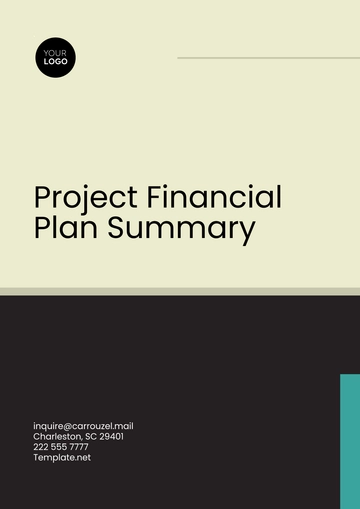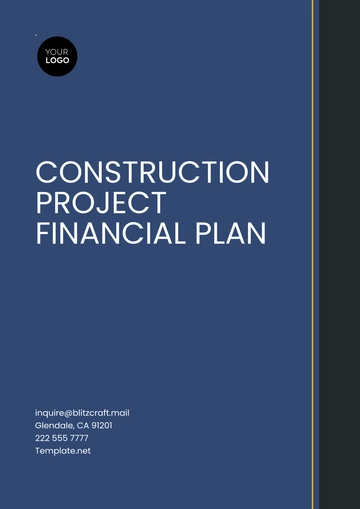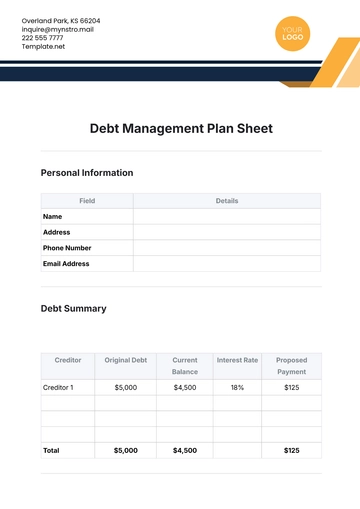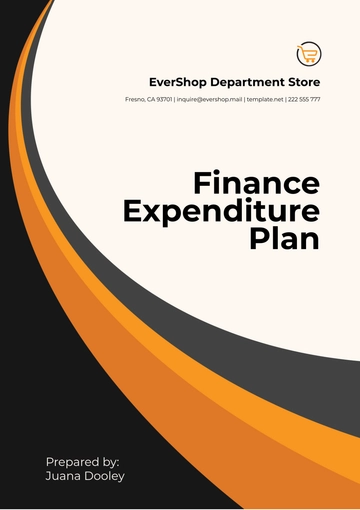Free Finance Plan

I. Introduction
At [Your Company Name], we recognize that a robust and well-structured Finance Plan is the cornerstone of our organization’s financial health and long-term success. This plan is designed to provide a clear roadmap for managing our financial resources, ensuring that we are well-equipped to meet our short-term obligations while also positioning ourselves for sustained growth and profitability in the future. By adhering to best practices in financial management and staying compliant with US law and regulatory standards, we aim to maximize the value we deliver to our stakeholders, including shareholders, employees, and clients.
The Finance Plan outlines our approach to critical financial processes, including budgeting, forecasting, investment management, and risk assessment. It provides detailed strategies for managing our revenue streams, controlling expenses, and optimizing our cash flow to maintain liquidity and financial stability. Additionally, this plan highlights our commitment to transparency and accountability in all financial matters, ensuring that we maintain the trust and confidence of our stakeholders. Through diligent execution of this plan, [Your Company Name] will not only achieve its financial objectives but also continue to innovate and grow, securing our place as a leader in the industry.
II. Objectives
The objectives of [Your Company Name]’s Finance Plan are designed to provide a clear and actionable framework for managing the financial aspects of our business. By setting specific and measurable goals, we aim to ensure that our financial resources are utilized effectively, supporting both short-term operations and long-term growth. These objectives serve as the foundation for our financial strategy, guiding our decisions and helping us navigate the complexities of the market while maintaining financial stability and compliance with US regulations. Achieving these objectives is crucial to our overall success and sustainability.
To establish a comprehensive understanding of current financial status.
To develop strategic financial goals and benchmarks.
To create an actionable plan to manage expenses and investments.
III. Current Financial Status
A thorough assessment of [Your Company Name]’s current financial status is essential to create a strong foundation for future planning. By understanding where we stand financially, we can make informed decisions that align with our strategic goals. This section outlines the key steps involved in evaluating our financial position, including an analysis of our assets, liabilities, and cash flow. Gaining a clear picture of our net worth and monthly financial dynamics will help us identify opportunities for improvement and areas that require more focused financial management.
To understand your current financial position, the following steps should be taken:
Compile a list of all assets and liabilities.
Calculate the net worth by subtracting liabilities from assets.
Analyze monthly income and expenditure to determine cash flow.
Category | Amount |
|---|---|
Assets | $100,000 |
Liabilities | $40,000 |
Net Worth | $60,000 |
Monthly Income | $5,000 |
Monthly Expenses | $3,500 |
Monthly Savings | $1,500 |
IV. Financial Goals
Setting clear and actionable financial goals is crucial for guiding [Your Company Name] toward achieving long-term success and stability. Establishing these goals helps ensure that our financial strategies are focused and aligned with our overall business objectives. By setting S.M.A.R.T. (Specific, Measurable, Achievable, Relevant, Time-bound) goals, we can create a roadmap for managing our resources effectively and tracking our progress. This section provides examples of how we can set and achieve financial milestones that contribute to both immediate and future financial health.
The financial goals include:
Short-term Goal: Save $5,000 for emergency fund within 12 months.
Medium-term Goal: Pay off $20,000 in student loans within 5 years.
Long-term Goal: Accumulate $500,000 in retirement savings within 20 years.
V. Budgeting and Expense Management
Effective budgeting and expense management are fundamental to maintaining financial stability and achieving our financial goals at [Your Company Name]. A well-structured budget helps control spending, ensures that resources are allocated efficiently, and facilitates savings. By following proven guidelines like the 50/30/20 rule, we can create a balanced approach to managing our income.
This section also provides practical tips for monitoring and adjusting expenses to align with our financial objectives, promoting healthier financial habits and better decision-making.
50% of income for necessities (housing, food, utilities).
30% of income for discretionary spending (entertainment, dining out).
20% of income for savings and debt repayment.
To manage expenses, consider the following tips:
Track Spending Using Budgeting Apps or Spreadsheets: Utilizing budgeting apps or maintaining a detailed spreadsheet helps monitor and categorize all expenditures. These tools provide insights into spending patterns, making it easier to identify areas where you might be overspending. Regularly reviewing this data enables you to adjust your budget and stay on track with your financial goals.
Reduce or Eliminate Non-Essential Costs: Assess your discretionary spending and identify non-essential expenses that can be minimized or eliminated. For instance, cutting back on frequent dining out, subscription services, or impulse purchases can free up more funds for savings or debt repayment. Prioritizing necessary expenses and distinguishing between wants and needs can significantly enhance your budget’s effectiveness.
Opt for Automatic Savings Withdrawals: Setting up automatic transfers to a savings account ensures that a portion of your income is consistently saved without requiring manual effort. This strategy promotes disciplined saving and helps build an emergency fund or contribute to long-term financial goals effortlessly.
VI. Investment Planning
Investment planning is a critical component of wealth growth and financial stability at [Your Company Name]. A well-thought-out investment strategy not only helps in accumulating wealth over time but also protects against market volatility and inflation. Diversification is a key principle in investment planning, as it spreads investments across various asset classes to balance risk and return. By diversifying, you reduce the impact of any single investment's poor performance on your overall portfolio.
Here are some common investment vehicles to consider:
Stocks: Investing in stocks involves purchasing shares of a company's equity, offering the potential for significant returns through capital appreciation and dividends. However, stocks can be volatile, so it’s essential to conduct thorough research and invest in companies with strong growth potential and stable financial performance.
Bonds: Bonds are debt securities issued by corporations or governments to raise capital. They typically provide a fixed interest income over time and are considered less risky than stocks. Bonds are suitable for investors seeking steady income and lower volatility in their portfolios.
Mutual Funds: Mutual funds pool money from multiple investors to invest in a diversified portfolio of stocks, bonds, or other securities. Managed by professional fund managers, mutual funds offer diversification and professional management but may come with management fees. They are a good option for investors seeking a hands-off approach.
Real Estate: Investing in real estate involves purchasing property for rental income or capital appreciation. Real estate can provide a stable income stream and potential tax benefits but requires significant capital and active management. It’s important to assess market conditions and property values before investing.
To tailor investments to your specific risk appetite and financial goals, consider consulting with a financial advisor. An advisor can provide personalized recommendations based on your investment objectives, risk tolerance, and time horizon. They help in creating a balanced investment strategy, ensuring that your portfolio aligns with your long-term financial goals while managing risk effectively. Regularly reviewing and adjusting your investment plan with professional guidance ensures continued alignment with your evolving financial needs and market conditions.
VII. Risk Management
Effective risk management is essential for safeguarding [Your Company Name]’s financial resources and ensuring long-term stability. Identifying and mitigating potential risks helps protect against unforeseen events that could impact financial well-being. Here are key strategies to manage and mitigate financial risks effectively:
Obtaining Appropriate Insurance Coverage: Insurance is a fundamental tool for risk management. Securing comprehensive coverage for health, life, and property helps protect against significant financial losses due to unexpected events. Health insurance ensures access to medical care without incurring substantial out-of-pocket expenses, while life insurance provides financial security to dependents in the event of an untimely death. Property insurance covers damages or losses to physical assets, including real estate and personal belongings. Evaluating coverage needs periodically and adjusting policies as necessary ensures adequate protection.
Setting Up an Emergency Fund: An emergency fund is a financial safety net designed to cover unexpected expenses or financial emergencies, such as medical bills, car repairs, or job loss. It is recommended to save enough to cover 3-6 months of living expenses, providing a buffer that helps avoid debt and financial strain during challenging times. Maintaining this fund in a readily accessible account, such as a savings account, ensures that it is available when needed.
Diversifying Investments: Diversification involves spreading investments across various asset classes to reduce exposure to any single investment's risk. By diversifying, you balance potential returns and mitigate the impact of market fluctuations on your overall portfolio. This strategy involves investing in a mix of stocks, bonds, mutual funds, and other assets to achieve a well-rounded portfolio. Regularly reviewing and rebalancing your investments helps maintain the desired level of diversification and aligns with changing market conditions and personal financial goals.
Implementing these risk management strategies provides a comprehensive approach to protecting financial resources and achieving financial security. Regularly reviewing and updating your risk management plan ensures that it remains effective and relevant to your evolving needs and circumstances.
VIII. Monitoring and Review
Regular monitoring and review of the financial plan are crucial for ensuring that [Your Company Name] remains on track to achieve its financial goals and adapt to changing circumstances. An effective financial plan is not a static document but a dynamic tool that requires ongoing evaluation to stay relevant and effective. Here are the key steps to maintaining a robust financial strategy:
Assessing the Financial Plan Quarterly or Annually: Regularly reviewing the financial plan—at least quarterly or annually—helps track progress toward goals and identifies areas where adjustments may be needed. This involves evaluating financial statements, budget adherence, and overall performance against the set objectives. Periodic assessments enable you to detect any discrepancies early and make informed decisions to keep the plan on course. This regular review process also helps ensure compliance with evolving regulatory requirements and industry standards.
Adjusting the Budget Based on Changes in Income/Expenses: Life events such as salary changes, new expenses, or unexpected financial challenges can impact your budget. It is essential to adjust the budget accordingly to reflect these changes accurately. This may involve reallocating resources, reducing discretionary spending, or revising savings goals. By updating the budget to match current financial realities, you maintain control over spending and ensure that financial resources are used effectively to meet both short-term and long-term goals.
Updating Financial Goals as Life Circumstances Evolve: As personal and professional circumstances change, so too should your financial goals. Major life events, such as marriage, having children, or career changes, can significantly alter your financial priorities and objectives. Regularly revisiting and updating your financial goals ensures that they remain relevant and achievable. This process involves reassessing your risk tolerance, investment strategy, and savings targets to align with your current life situation and future aspirations.
By implementing a structured approach to monitoring and reviewing your financial plan, you ensure that it remains aligned with your evolving needs and goals. This proactive management helps safeguard financial health, adapt to changes, and achieve sustained success. Regular updates and adjustments are essential for maintaining financial stability and advancing toward your desired outcomes.
IX. Conclusion
A well-structured financial plan is vital for the success and stability of [Your Company Name]. By implementing a comprehensive approach to budgeting, expense management, investment planning, and risk management, we position ourselves to achieve both short-term and long-term financial goals. This plan serves as a strategic guide, enabling us to allocate resources efficiently, safeguard against potential risks, and adapt to changing circumstances. Regular monitoring and review ensure that our financial strategies remain aligned with our evolving needs and market conditions.
The commitment to diligent financial management not only supports our immediate objectives but also lays the foundation for sustained growth and prosperity. By following the outlined strategies and continually assessing our financial status, we can make informed decisions that drive profitability and enhance our financial well-being. This proactive approach fosters a resilient financial framework, empowering [Your Company Name] to navigate challenges, seize opportunities, and achieve lasting success. Our financial plan is a dynamic tool that reflects our dedication to maintaining financial health and advancing our strategic vision.
- 100% Customizable, free editor
- Access 1 Million+ Templates, photo’s & graphics
- Download or share as a template
- Click and replace photos, graphics, text, backgrounds
- Resize, crop, AI write & more
- Access advanced editor
Streamline your financial planning with our Finance Plan Template, available on Template.net. Fully customizable and editable, this template can be tailored to meet your specific needs. Easily edit in our AI Editor Tool, ensuring a professional and polished finance plan every time. Perfect for businesses seeking efficiency and clarity.
You may also like
- Finance Plan
- Construction Plan
- Sales Plan
- Development Plan
- Career Plan
- Budget Plan
- HR Plan
- Education Plan
- Transition Plan
- Work Plan
- Training Plan
- Communication Plan
- Operation Plan
- Health And Safety Plan
- Strategy Plan
- Professional Development Plan
- Advertising Plan
- Risk Management Plan
- Restaurant Plan
- School Plan
- Nursing Home Patient Care Plan
- Nursing Care Plan
- Plan Event
- Startup Plan
- Social Media Plan
- Staffing Plan
- Annual Plan
- Content Plan
- Payment Plan
- Implementation Plan
- Hotel Plan
- Workout Plan
- Accounting Plan
- Campaign Plan
- Essay Plan
- 30 60 90 Day Plan
- Research Plan
- Recruitment Plan
- 90 Day Plan
- Quarterly Plan
- Emergency Plan
- 5 Year Plan
- Gym Plan
- Personal Plan
- IT and Software Plan
- Treatment Plan
- Real Estate Plan
- Law Firm Plan
- Healthcare Plan
- Improvement Plan
- Media Plan
- 5 Year Business Plan
- Learning Plan
- Marketing Campaign Plan
- Travel Agency Plan
- Cleaning Services Plan
- Interior Design Plan
- Performance Plan
- PR Plan
- Birth Plan
- Life Plan
- SEO Plan
- Disaster Recovery Plan
- Continuity Plan
- Launch Plan
- Legal Plan
- Behavior Plan
- Performance Improvement Plan
- Salon Plan
- Security Plan
- Security Management Plan
- Employee Development Plan
- Quality Plan
- Service Improvement Plan
- Growth Plan
- Incident Response Plan
- Basketball Plan
- Emergency Action Plan
- Product Launch Plan
- Spa Plan
- Employee Training Plan
- Data Analysis Plan
- Employee Action Plan
- Territory Plan
- Audit Plan
- Classroom Plan
- Activity Plan
- Parenting Plan
- Care Plan
- Project Execution Plan
- Exercise Plan
- Internship Plan
- Software Development Plan
- Continuous Improvement Plan
- Leave Plan
- 90 Day Sales Plan
- Advertising Agency Plan
- Employee Transition Plan
- Smart Action Plan
- Workplace Safety Plan
- Behavior Change Plan
- Contingency Plan
- Continuity of Operations Plan
- Health Plan
- Quality Control Plan
- Self Plan
- Sports Development Plan
- Change Management Plan
- Ecommerce Plan
- Personal Financial Plan
- Process Improvement Plan
- 30-60-90 Day Sales Plan
- Crisis Management Plan
- Engagement Plan
- Execution Plan
- Pandemic Plan
- Quality Assurance Plan
- Service Continuity Plan
- Agile Project Plan
- Fundraising Plan
- Job Transition Plan
- Asset Maintenance Plan
- Maintenance Plan
- Software Test Plan
- Staff Training and Development Plan
- 3 Year Plan
- Brand Activation Plan
- Release Plan
- Resource Plan
- Risk Mitigation Plan
- Teacher Plan
- 30 60 90 Day Plan for New Manager
- Food Safety Plan
- Food Truck Plan
- Hiring Plan
- Quality Management Plan
- Wellness Plan
- Behavior Intervention Plan
- Bonus Plan
- Investment Plan
- Maternity Leave Plan
- Pandemic Response Plan
- Succession Planning
- Coaching Plan
- Configuration Management Plan
- Remote Work Plan
- Self Care Plan
- Teaching Plan
- 100-Day Plan
- HACCP Plan
- Student Plan
- Sustainability Plan
- 30 60 90 Day Plan for Interview
- Access Plan
- Site Specific Safety Plan





























